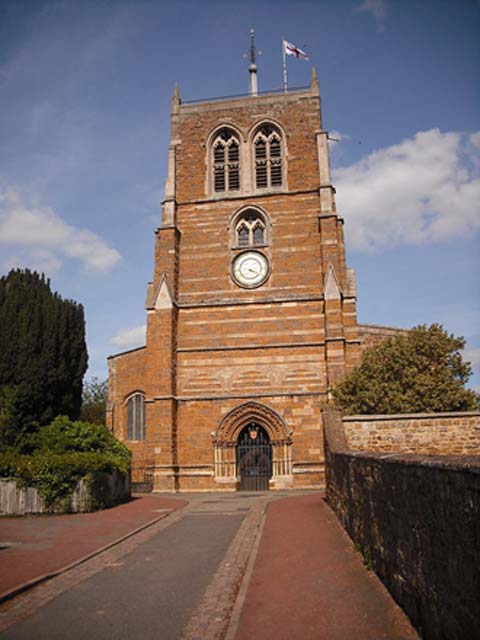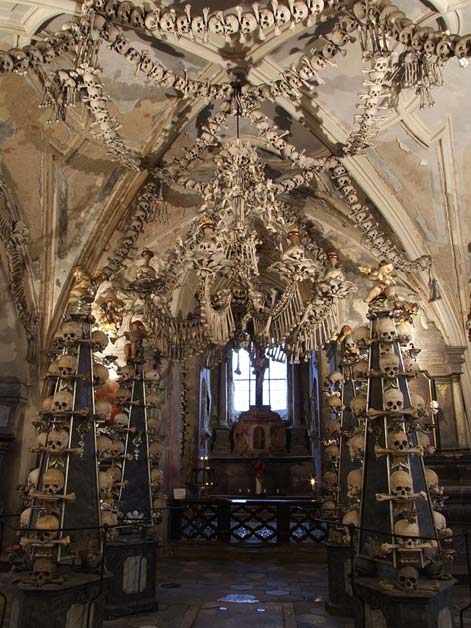
2500 Bodies fill Rare Charnel Chapel in England - Hidden House of Bones Revealed in 3D
A hidden hall of bones containing the remains of thousands of dead was a secret kept for centuries. 3D scans of the shocking find now bring light to the dark chambers, revealing England’s best-surviving medieval charnel chapel.
Digging into the Past
Local legend says in the 1700s, a grave digger, at his work, swung his pick. The ground gave way and he tumbled headlong into a dark chamber, to be met with a horrifying sight: white, grinning skulls and piles of skeletal remains in every direction. He had inadvertently discovered the long-forgotten charnel house beneath Holy Trinity church in Rothwell, Northamptonshire, England.

Skulls line shelves at the Charnel House at Rothwell, Northamptonshire. (Image: Holy Trinity Church)
According to The Guardian, the charnel house – or bone store – at Rothwell, dating to the 13th century is of international importance. The interior of the charnel house and has been scanned and recreated digitally by scientists and archaeologists of the University of Sheffield, UK.
- The Eerie Bone Church of 40,000 Souls
- Old skeletons, possibly plague victims, found under Paris grocery
- Would You Visit Five Centuries of Bones? The Scary Spanish Ossuary of Wamba
Archaeologist and leader of the Sheffield University research project, Lizzy Craig-Atkins told The Guardian: “Rothwell charnel chapel is a site of major international significance. Surviving charnel chapels, with human remains still housed inside, are very rare in England. What is so fascinating about the Rothwell charnel chapel is that it presents an ideal archaeological resource for researchers to use to advance our understanding of how the remains of the dead were treated during the medieval period.”
Skulls and Bones
The charnel house is unique as it’s believed to be one of only two medieval charnel houses in England which still holds their original human remains in situ. The dark chapel is stuffed with wooden racks of bones, along all the walls, from floor to ceiling, with the remains of over 2,500 people, made up of thousands of people who died in Britain between the 13th and 16th centuries, notes the University of Sheffield.

Bones line the walls and are collected in a central pile in the charnel house, Rothwell. (Image: University of Sheffield).
Charnel houses or ossuaries are vaults or underground chambers, usually built near churches, to store the overflow of bones after they’ve been dug up from cemeteries when burial space is scarce. The newly dead will be buried in graveyards, and then later dug up and interred in the charnel house. The bones can get mixed up and it’s not clear who is who at the other end of history. Identifying bodies and matching skulls to bones is a challenge for archaeologists. The church’s earliest foundations date back to the 12th century and were erected on an earlier Saxon site.
Early theories about the bones [Holy Trinity Church], (which have since been disproved and put to rest by historians and researchers) include that they belonged to:
- “Danes slain in battle by the Saxons (published in a lecture sometime before 1878 by Major George Whyte-Melville),
- a novelist of fox-hunting stories who rather paradoxically met his death while hunting in 1878,
- men slain at Naseby Battlefield 1645 (eight miles away) or at Bosworth Battlefield 1485 (thirty miles away),
- remains of a monastic burial place, or
- victims of a plague epidemic.”

Holy Trinity Church, Rothwell, UK. (Martinevans123/CC BY-SA 3.0)
University of Sheffield researchers reportedly have identified nearly 60 possible bone store sites throughout the UK – however they may not be as well preserved as the Rothwell example. Other countries famously hold examples of huge ossuaries containing shocking numbers of bones, such as the incredible catacombs beneath Paris, France, stretching 11,000 square meters (nearly three acres) and holding six million dead. The Sedlec Ossuary in the Czech Republic famously uses the bones of up to 70,000 people to decorate the interior.

The Sedlec chapel Interior (Pudelek/GFDL)
The Living Visit the Realm of the Dead
While the charnel house was sealed up and apparently forgotten, it was reportedly intended to be visited by the living. Craig-Atkins noted that the chapel was at one time lit by two windows, and one of the walls sported a panting of the Resurrection.
- Chemical analysis on ancient stone bone box reignites debate over alleged family of Jesus
- Evicted from a Cemetery and into a Museum: The Multitude of Mummies of Guanajuato
- The Hellfire Caves of West Wycombe
Researchers at the University of Sheffield report that the discovery of this well-preserved medieval charnel house provides new insights into funerary practices in medieval Britain. Dr Steve Maddock from the University’s Department of Computer Science, said: “This fascinating project presented us with some unique challenges in creating the model, with important lessons learnt for future cultural heritage projects.”

Piles of bones in the Rothwell charnel house. (Image: Holy Trinity Church)
The Rothwell Charnel Chapel Project’s website writes that the research is a large-scale community initiative, involving staff and students of the university, local stakeholders and researchers, who collaborate through academic publications, local media, group activities, and social networking.
The charnel house is seasonally open for visitors one Sunday a month, but the deepest reaches of the chapel are not always accessible, due to the sheer volume of remains. This is where the online 3D recreation and video shines. Craig-Atkins explains, “This new digital resource provides an opportunity for people all over the world to explore the site and helps us to preserve this fascinating window into the past for future generations.”
Top Image: Skulls and bones are piled high at the charnel house Rothwell, Northamptonshire, England. (Public Domain)
By Liz Leafloor














